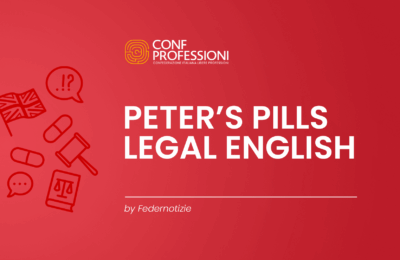Nuovo appuntamento con “Peter’s Pills“, la rubrica online di Legal English by Federnotizie (la rivista online di Federnotai), in collaborazione con Confprofessioni e Beprof. La decima video-lezione “Matrimonial regimes” è disponibile sul sito www.federnotizie.it, sui canali social e sul sito di Confprofessioni e sulla app Beprof, scaricabile da App Store e Google Play.
Transcript:
Hello!
Matrimonial regimes, or marital property systems can be divided into two main systems, namely:
• The Separate Property System and
• The Community Property System
Many jurisdictions accept prenuptial agreements which are also called “prenups” or “antenuptial contracts”. These will supersede many of the default marital laws that would otherwise (diversamente) apply in the event of divorce.
Conflict in national laws means that there is no umbrella term for the rules within different systems Variations of Separate Property System include:
• Separate Property: where all pre-marital or marital property is owned separately.
• Separate Property with Equitable Distribution: when most of the property acquired during the marriage is owned by only one spouse, courts will grant (concederanno) an equitable (equo) distribution of the richer spouse’s property at divorce or death.
• Accrual System or Deferred Community Property: where property is owned separately during the marriage, but after divorce or death of a spouse, the assets are put together as joint tenancy, “where both spouses own everything totally”, and the property is then divided equally.
• Tenancy by the Entirety (TBE): in which spouses are treated as one person, each having an equal ownership interest in the property. In some U.S. states, tenancy by the entirety is limited to realty (beni immobili) while in other states it is available for both realty and personalty (beni mobili).
Variations of Community Property System include:
• Community of Acquests and Gains: where each spouse owns an undivided half-interest in all assets acquired during marriage, excluding property acquired by gift or inheritance during the marriage, and excluding separate property acquired before the marriage, and excluding property which is acquired during a period when the couple are permanently living apart.
• Community of Profit and Loss: which is similar to “Community of Acquests and Gains” but liabilities (debiti), or “losses”, are separate property.
• Community of Personal and Marital Property: where community property consists of all personalty and realty (beni mobili e immobili) acquired during the marriage as well as all personalty acquired before the marriage, but realty acquired before marriage is separately owned.
• Limited Community Property: which is similar to Community of Acquests and Gains, but certain marital property is separate property.
• Universal or Absolute Community Property: where all pre-marital and marital property is community property. However, if there are children from a prior marriage, the property associated with that marital community may be segregated from the community property of a subsequent marriage, to ensure the children of the prior spouse have an inheritance.
Thank you, and see you next time for more Peter’s Pills to improve your legal English.
—————————————————————————————————————
For your interest:
Look here for a comparative explanation of the rules relating to the division of marital property of spouses that have an international element to their relationship in cases of divorce, separation or death in certain European countries:
https://e-justice.europa.eu/content_matrimonial_property_regimes-36686-en.do



